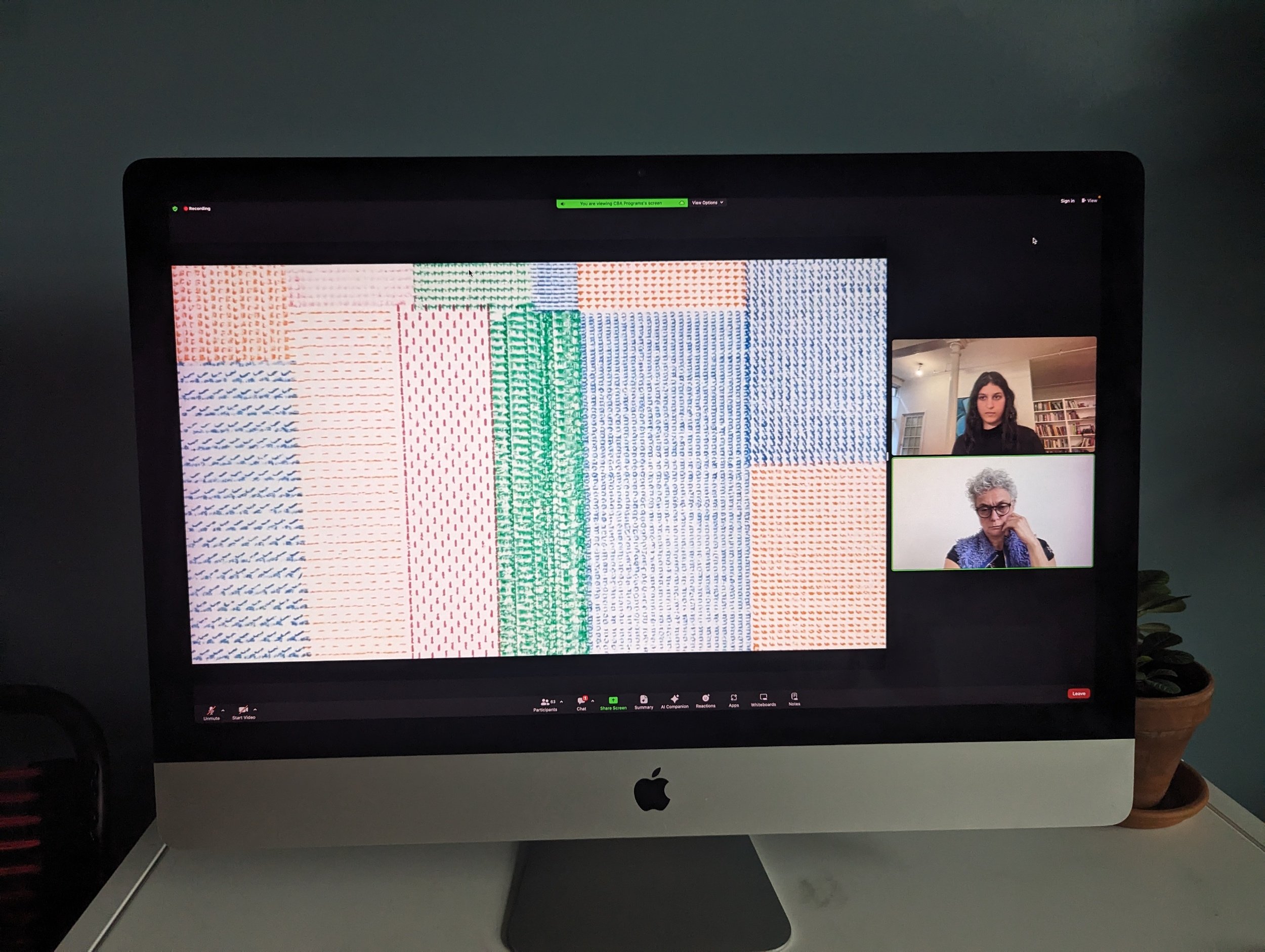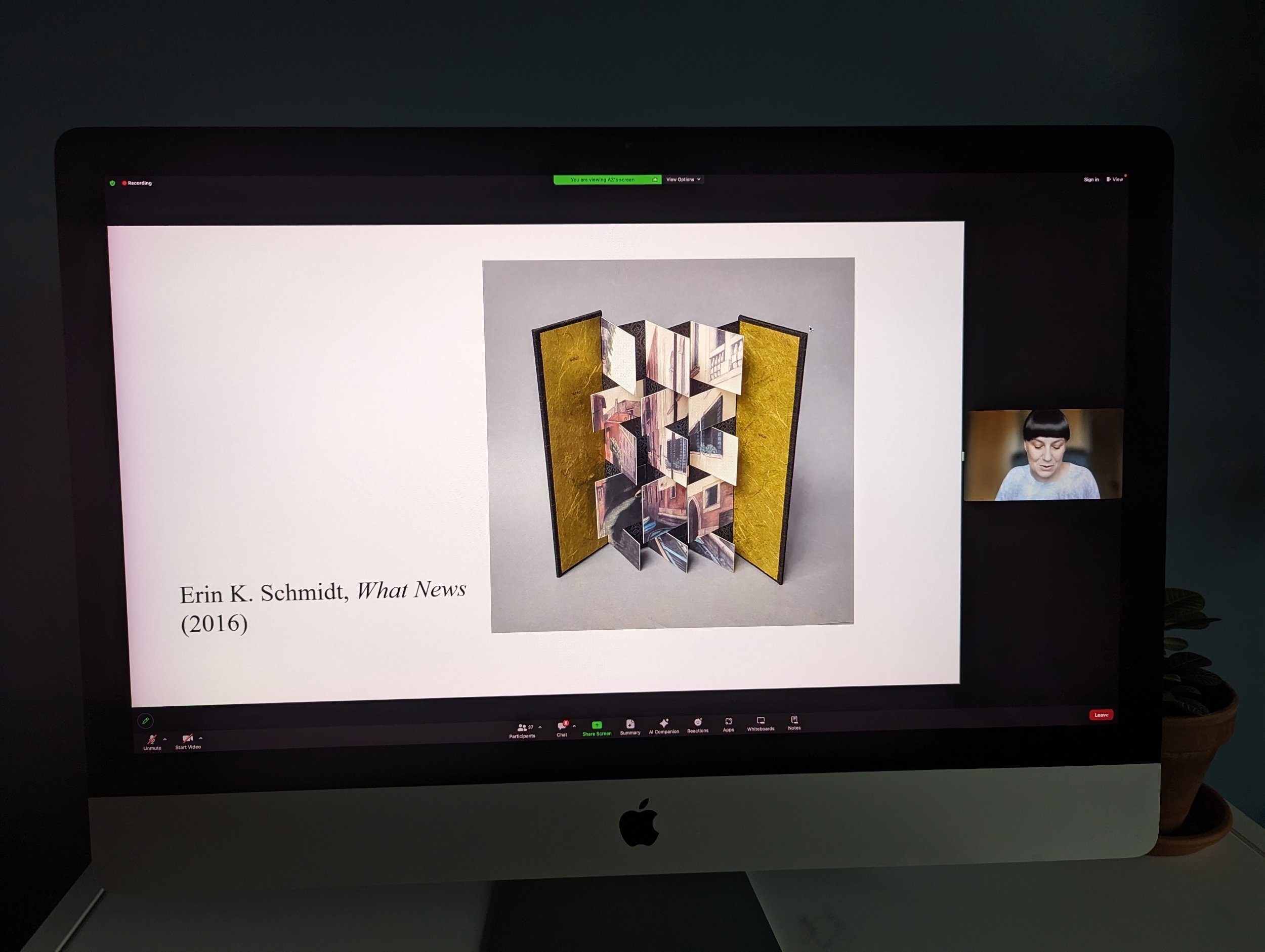Artists’ Book as Expanded Literacy: What We Learned from Asemic Writing



The 2024 Contemporary Artists Books Conference is happening! The theme of this year is “Artists’ Books as Expanded Literacy”.
For anyone who is not a book nerd: an artist’s book is a piece of art that utilizes the form of a book as its medium. It’s often published in small editions or made as an one-of-a-kind object.
Artists often choose a manual printing process, such as monotype printing, screen printing, using a typewriter… as well as manipulating unique materials, such as foil, textile, handmade paper… to express their content.
This studio visit video of book artist Raffaella della Olga shows one example of such artists’ book: she modified vintage typewriters to press abstract graphic art onto various papers. These books are often collected by libraries, museums or private patrons. Thanks to the advancement of printing technology, though, nowadays we can see more fine prints that are between commercial books and artists’ books, sold in bookstores.
If the “normal” books are on a mission to disseminate information as efficiently as possible, then the artists’ books are here to challenge the assumption of linear text as the default mode of communication, and to push the boundary of human cognition.
As Claudia de la Torre said in her keynote speech given at the conference:
Artists’ books can broaden our understanding of literacy beyond traditional forms of reading and writing. They serve as vehicles for expanding literacy skills by engaging readers in new ways of interpreting and interacting with visual and textual content. Unlike traditional books, which primarily rely on linear narratives and standardized formats, artists’ books encourage readers to navigate through complex visual and textual layers, challenging them to actively participate in the creation of meaning.
In other words, artists’ books acknowledge that meaning exists beyond text. The empty space on a page, the graphic symbols, even the texture of the paper itself, are part of the meaning.
At this conference, two themes emerged to intertwine: asemic writing and how it’s forging the neurodivergent literacy for the next generation.
Asemic Writing - History: Having fun preceded having a meaning
Asemic writing is defined as a form of writing that lacks specific semantic content, allowing readers to interpret the symbols and forms in their own way. It’s a form of symbolism lying in between formulated and publicly understood text and pure graphic expressions.
The phrase “asemic writing” emerged in the late 20th and early 21st centuries, rooted in various avant-garde movements - think of Dadaism, Surrealism, and Abstract Expressionism - which emphasized the visual and symbolic qualities of language over its semantic meaning.
While the avant-garde movements belonged to contemporary Europe, the abstract expression of text existed in history. As early as in 8th century China, during Tang dynasty, intellectuals began to develop a taste for calligraphy works that weren’t necessarily meant to be legible, but communicated emotionally and visually via their graphic quality.
Zhang Xu (張旭) was believed to be the first artist who pioneered the calligraphic style madly cursive script (狂草). As one of the Eight Immortals of the Wine Cup (飲中八仙), Zhang was known to perform calligraphy art when he was drunk. While it’s hard to tell what characters Zhang wrote, supposedly a poem, his art has been greatly appreciated by his contemporaries as well as today’s art collectors.
The interesting thing is, contemporary artists are pushing meaning out of their hand writing to make a statement, hence the invention of the phrase “asemic writing”, whereas during Zhang’s time, neither the artist nor the audience seemed too bothered with the meaning of the writing. They just enjoyed the process of the creation.
Asemic Writing - Present: Rebelling against the cultural establishment
This brings the up the topic presented by Gaby Hernández: rebelling against the colonial visual culture establishment. The artistic expression of indigenous people and that of the immigrants from “other” sides of the world is often deemed to be “unsophisticated” by the Western European standard. There is an imposed canonical aesthetics in the post-colonial world that the mainstream design professionals would be expected to adhere to.
As a design researcher and assistant professor of graphic design at the University of Florida, Hernández views artists’ books as a medium to express and record “the immense divergence of our cosmovision”.
Hernández’s presentation title: The Role of Asemic Writing and Artists’ Books in Decolonial Design Research
Hernández states that “Evolution is the constant unlearning and relearning about our context and ourselves”. Originated from Central America, she is keenly aware of the cultural and aesthetic hierarchy existed in the society’s collective subconsciousness. The European aesthetics are “fine art”, and the local, indigenous aesthetics are “folk art”.
However, “each of us is born with unique interpretations of the world. When discovered and nurtured, this can evolve into visual languages that are as peculiar as our fingerprints”. “The liberatory characteristics of artists’ books support the discovery and documentation of unique visual languages” through experimentations. “Artists’ books are, therefore, accessible tools to individually resist canonical aesthetics imposed by Western European imaginaries”.
She concludes, “in visual communication and design research, resisting colonialist and canonical impositions helps expand our understanding of design across the world and across time, as a plur-iversal and innately human way to express curiosity and preserve knowledge.”
Asemic Writing - Future: Teaching the neurodiversity
The conference ended with a panel of educators teaching kids and adults faced with cognitive challenges. Ari Wolff, John Bonanni, and Warren Lehrer are all fantastic humans.
Ari Wolff introduced herself with her asemic writing work, a letter-like polymer clay knots making up “sentences”. Her website has a great introduction to this work. As a neurodivergent person herself, she had struggled with the traditional schooling that focused on reading and calculating, which eventually drove her to pursue arts. Now an artist and educator, she collaborated with school kids at 14th-Street Y to create a series of artists books ( see Citation Needed )
Ari Wolff flipping through one of the books during presentation
At the first glance the books produced by the grade schoolers looked no more different from doodles you’d see on a kid’s notebook, so often dismissed by adults. By taking these doodles seriously, encouraging the kids to work out the message they’d want to communicate, and helping them to crystalize their ideas into a book format, Ari Wolff created a safe environment for kids to experiment and evolve their expressions.
Reading and writing are often taught as a linear experience. Admittedly, although I managed to get through academia, I never enjoyed reading chunky paragraphs. Even when I read an exciting fiction book and I am fully drawn into the story, I struggle to turn the page. If a book doesn’t call for dancing arrangement of its typography and has no pictures involved, I would always opt for its audiobook companion (God bless Audible!)
So when Ari Wolff pulled out this slide, I immediately resonated:
Reading is a web of experiences, including physical, emotional, visual and mental interpretations of what’s being imagined through the reader’s mind.
I’ve only become aware of the fact recently that I might have some ADHD syndrome, thanks to wonderful Jak Levine-Pritzker, an ADHD coach who challenges the idea that a stereotypical ADHD is a 12-year old boy who can’t sit still. ADHD in girls could go on for years and decades without ever been diagnosed, because girls were expected to follow the rules and do their homework as well as they can. And girls comply to what’s expected of them more than boys do. Undiagnosed ADHD in girls, who later become seemingly hight-functioning women, harbor immense shame because they constantly feel they have to struggle a lot more to meet the “expectations”. And what are the “expectations”?
Expecting individuals to learn or gain knowledge by reading or writing.
Associating low empathy with having low morals or values.
Expecting everyone to communicate using spoken communication.
Labelling hearing voices as a sign of illness.
Enforcing linear clock time and a 9 to 5 work schedule.
These are a few examples of what the society considers as “normal”, thus expected. Sonny Jane Wise coined the term “neuronormativity”, to describe the enforced normality, as an opposition to a more degrading term “neurodivergency” to describe the marginalized:
Neurormativity is a set of norms, standards, expectations and ideals that centre a particular way of functioning as the right way to function. It is the assumption that there is a correct way to exist in this world; a correct way to think, feel, communicate, play, behave and more.
… …
Neuronormativity is centered in such a way that when we diverge from neuronormativity and how society expects us to function, we are labelled as having a disorder; we are seen as abnormal, unwell or having deficits.
And we are NOT abnormal. The way we perceive information is NOT a disorder. What needs to change is not us, but the so-called “norms” that suffocates everyone, including the neurotypical people.
That’s what I took away from this year’s Artists’ Book conference: we can expand the conventional conception of literacy by incorporating our visual and tactile experiences as part of the literacy itself.








